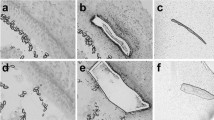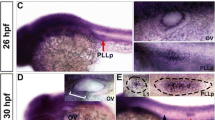Abstract
The enhancer of zeste 2 polycomb repressive complex 2 subunit (Ezh2) is a histone-lysine Nmethyltransferase enzyme that participates in DNA methylation. Ezh2 has also been reported to play crucial roles in stem cell proliferation and differentiation. However, the detailed expression profile of Ezh2 during mouse cochlear development has not been investigated. Here, we examined the spatiotemporal expression of Ezh2 in the cochlea during embryonic and postnatal development. Ezh2 expression began to be observed in the whole otocyst nuclei at embryonic day 9.5 (E9.5). At E12.5, Ezh2 was expressed in the nuclei of the cochlear prosensory epithelium. At E13.5 and E15.5, Ezh2 was expressed from the apical to the basal turns in the nuclei of the differentiating cochlear epithelium. At postnatal day (P) 0 and 7, the Ezh2 expression was located in the nuclei of the cochlear epithelium in all three turns and could be clearly seen in outer and inner hair cells, supporting cells, the stria vascularis, and spiral ganglion cells. Ezh2 continued to be expressed in the cochlear epithelium of adult mice. Our results provide the basic Ezh2 expression pattern and might be useful for further investigating the detailed role of Ezh2 during cochlear development.
Similar content being viewed by others
References
Layman WS, Zuo J. Epigenetic regulation in the inner ear and its potential roles in development, protection, and regeneration. Front Cell Neurosci 2014; 8: 446
Uribe RA, Buzzi AL, Bronner ME, Strobl-Mazzulla PH. Histone demethylase KDM4B regulates otic vesicle invagination via epigenetic control of Dlx3 expression. J Cell Biol 2015; 211(4): 815–827
Hurd EA, Poucher HK, Cheng K, Raphael Y, Martin DM. The ATPdependent chromatin remodeling enzyme CHD7 regulates proneural gene expression and neurogenesis in the inner ear. Development 2010; 137(18): 3139–3150
Roellig D, Bronner ME. The epigenetic modifier DNMT3A is necessary for proper otic placode formation. Dev Biol 2016; 411(2): 294–300
Stojanova ZP, Kwan T, Segil N. Epigenetic regulation of Atoh1 guides hair cell development in the mammalian cochlea. Development 2015; 142(20): 3529–3536
Viré E, Brenner C, Deplus R, Blanchon L, Fraga M, Didelot C, Morey L, Van Eynde A, Bernard D, Vanderwinden JM, Bollen M, Esteller M, Di Croce L, de Launoit Y, Fuks F. The Polycomb group protein EZH2 directly controls DNA methylation. Nature 2006; 439 (7078): 871–874
Morey L, Helin K. Polycomb group protein-mediated repression of transcription. Trends Biochem Sci 2010; 35(6): 323–332
Ezhkova E, Pasolli HA, Parker JS, Stokes N, Su IH, Hannon G, Tarakhovsky A, Fuchs E. Ezh2 orchestrates gene expression for the stepwise differentiation of tissue-specific stem cells. Cell 2009; 136 (6): 1122–1135
Juan AH, Derfoul A, Feng X, Ryall JG, Dell’Orso S, Pasut A, Zare H, Simone JM, Rudnicki MA, Sartorelli V. Polycomb EZH2 controls self-renewal and safeguards the transcriptional identity of skeletal muscle stem cells. Genes Dev 2011; 25(8): 789–794
Yin J, Leavenworth JW, Li Y, Luo Q, Xie H, Liu X, Huang S, Yan H, Fu Z, Zhang LY, Zhang L, Hao J, Wu X, Deng X, Roberts CW, Orkin SH, Cantor H, Wang X. Ezh2 regulates differentiation and function of natural killer cells through histone methyltransferase activity. Proc Natl Acad Sci USA 2015; 112(52): 15988–15993
Jing H, Liao L, An Y, Su X, Liu S, Shuai Y, Zhang X, Jin Y. Suppression of EZH2 prevents the shift of osteoporotic MSC fate to adipocyte and enhances bone formation during osteoporosis. Mol Ther 2016; 24(2): 217–229
Yoo KH, Oh S, Kang K, Hensel T, Robinson GW, Hennighausen L. Loss of EZH2 results in precocious mammary gland development and activation of STAT5-dependent genes. Nucleic Acids Res 2015; 43(18): 8774–8789
Mochizuki-Kashio M, Aoyama K, Sashida G, Oshima M, Tomioka T, Muto T, Wang C, Iwama A. Ezh2 loss in hematopoietic stem cells predisposes mice to develop heterogeneous malignancies in an Ezh1-dependent manner. Blood 2015; 126(10): 1172–1183
Snitow ME, Li S, Morley MP, Rathi K, Lu MM, Kadzik RS, Stewart KM, Morrisey EE. Ezh2 represses the basal cell lineage during lung endoderm development. Development 2015; 142(1): 108–117
Galvis LA, Holik AZ, Short KM, Pasquet J, Lun AT, Blewitt ME, Smyth IM, Ritchie ME, Asselin-Labat ML. Repression of Igf1 expression by Ezh2 prevents basal cell differentiation in the developing lung. Development 2015; 142(8): 1458–1469
Zhang J, Ji F, Liu Y, Lei X, Li H, Ji G, Yuan Z, Jiao J. Ezh2 regulates adult hippocampal neurogenesis and memory. J Neurosci 2014; 34(15): 5184–5199
Juan AH, Kumar RM, Marx JG, Young RA, Sartorelli V. Mir-214- dependent regulation of the polycomb protein Ezh2 in skeletal muscle and embryonic stem cells. Mol Cell 2009; 36(1): 61–74
Chen Y, Li L, Ni W, Zhang Y, Sun S, Miao D, Chai R, Li H. Bmi1 regulates auditory hair cell survival by maintaining redox balance. Cell Death Dis 2015; 6: e1605
Lu X, Sun S, Qi J, Li W, Liu L, Zhang Y, Chen Y, Zhang S, Wang L, Miao D, Chai R, Li H. Bmi1 regulates the proliferation of cochlear supporting cells via the canonical Wnt signaling pathway. Mol Neurobiol 2016 Feb 3. [Epub ahead of print] DOI: 10.1007/s12035- 016-9686-8
Radde-Gallwitz K, Pan L, Gan L, Lin X, Segil N, Chen P. Expression of Islet1 marks the sensory and neuronal lineages in the mammalian inner ear. J Comp Neurol 2004; 477(4): 412–421
Morsli H, Choo D, Ryan A, Johnson R, Wu DK. Development of the mouse inner ear and origin of its sensory organs. J Neurosci 1998; 18(9): 3327–3335
Chen P, Johnson JE, Zoghbi HY, Segil N. The role of Math1 in inner ear development: Uncoupling the establishment of the sensory primordium from hair cell fate determination. Development 2002; 129(10): 2495–2505
Fekete DM, Muthukumar S, Karagogeos D. Hair cells and supporting cells share a common progenitor in the avian inner ear. J Neurosci 1998; 18(19): 7811–7821
Simon JA, Kingston RE. Mechanisms of polycomb gene silencing: knowns and unknowns. Nat Rev Mol Cell Biol 2009; 10(10): 697–708
Kim KH, Roberts CW. Targeting EZH2 in cancer. Nat Med 2016; 22 (2): 128–134
Yoo KH, Hennighausen L. EZH2 methyltransferase and H3K27 methylation in breast cancer. Int J Biol Sci 2012; 8(1): 59–65
Varambally S, Dhanasekaran SM, Zhou M, Barrette TR, Kumar-Sinha C, Sanda MG, Ghosh D, Pienta KJ, Sewalt RG, Otte AP, Rubin MA, Chinnaiyan AM. The polycomb group protein EZH2 is involved in progression of prostate cancer. Nature 2002; 419(6907): 624–629
Zingg D, Debbache J, Schaefer SM, Tuncer E, Frommel SC, Cheng P, Arenas-Ramirez N, Haeusel J, Zhang Y, Bonalli M, McCabe MT, Creasy CL, Levesque MP, Boyman O, Santoro R, Shakhova O, Dummer R, Sommer L. The epigenetic modifier EZH2 controls melanoma growth and metastasis through silencing of distinct tumour suppressors. Nat Commun 2015; 6: 6051
Arisan S, Buyuktuncer ED, Palavan-Unsal N, Caskurlu T, Cakir OO, Ergenekon E. Increased expression of EZH2, a polycomb group protein, in bladder carcinoma. Urol Int 2005; 75(3): 252–257
Lund K, Adams PD, Copland M. EZH2 in normal and malignant hematopoiesis. Leukemia 2014; 28(1): 44–49
Layman WS, Sauceda MA, Zuo J. Epigenetic alterations by NuRD and PRC2 in the neonatal mouse cochlea. Hear Res 2013; 304: 167–178
Author information
Authors and Affiliations
Corresponding authors
Additional information
These authors contributed equally to this work.
Rights and permissions
About this article
Cite this article
Chen, Y., Li, W., Li, W. et al. Spatiotemporal expression of Ezh2 in the developing mouse cochlear sensory epithelium. Front. Med. 10, 330–335 (2016). https://doi.org/10.1007/s11684-016-0459-6
Received:
Accepted:
Published:
Issue Date:
DOI: https://doi.org/10.1007/s11684-016-0459-6




